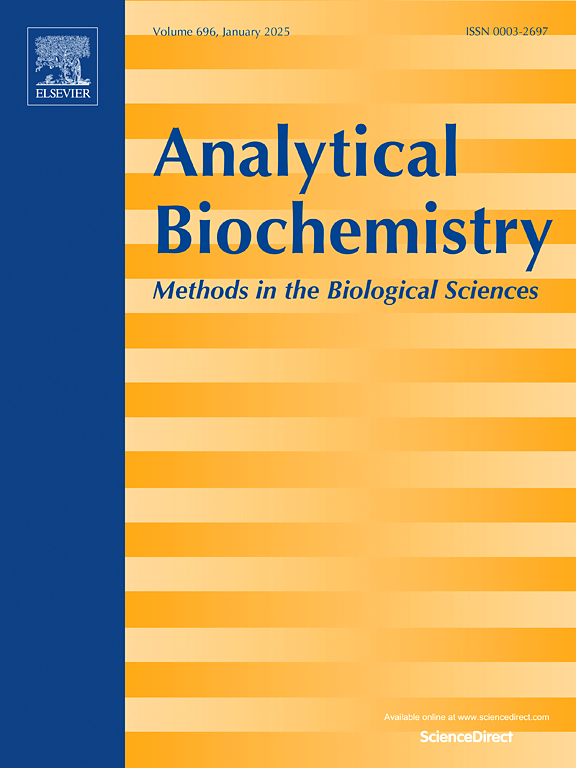牛津纳米孔第三代测序分析fmr15 ' utr CGG重复扩增。
IF 2.5
4区 生物学
Q2 BIOCHEMICAL RESEARCH METHODS
引用次数: 0
摘要
目的:脆性X综合征主要由fmr15 ' utr区富含gc - cytosin -guanine-guanine (CGG)重复扩增以及其开放阅读框中罕见的基因点突变或缺失引起。目前,第三代长读测序是同时检测CGG重复扩增、点突变和缺失的潜在技术。然而,获得具有超高GC含量的目标长片段CGG重复区域进行测序仍然是一个主要的挑战。方法:我们开发了一种结合长片段超高GC聚合酶链反应(PCR)扩增和牛津纳米孔测序的新方法来检测fmr15 ' utr CGG重复突变的全谱。使用10个标准细胞系样本(雄性:非正常=1,中间=1,预突变=1,完全突变=2)验证方法;女性:异常=1,非中间=1,npre-mutation=2, nfull突变=1),53份回顾性临床血样(男性:异常=7,npre-mutation=3, nfull突变=15,nmosaic突变=2;女性:nnormal=9, npremutation =13, nfull mutation=4)。结果:对10份细胞系样本和53份临床样本进行基因分型,结果与三联体重复引物PCR和Southern blot分析的一致性为100%。此外,CGG重复数与参考方法有很强的相关性(雄性细胞系,n=5, R2=0.9996;雌性细胞系,n=5, R2=0.9972;临床男性样本,n=26, R2=1.0000;临床女性样本,n=25, R2=0.9854)。结论:本研究为第三代测序提供了一种简单、经济的fmr15 ' utr CGG重复区长片段超高GC含量制备策略。这种方法可以作为一种模型,用于检测由短串联重复扩增引起的其他具有挑战性的疾病,如肌强直性营养不良和亨廷顿病。本文章由计算机程序翻译,如有差异,请以英文原文为准。

Oxford Nanopore third generation sequencing for analysis of FMR1 5′UTR CGG repeat expansions
Objective
Fragile X syndrome is mainly caused by the expansion of GC-rich cytosine-guanine-guanine (CGG) repeat in FMR1 5′UTR region, as well as rare gene point mutations or deletions in its open reading frame. Currently, third-generation long-read sequencing is a potential technology for simultaneously detecting CGG repeat expansions, point mutations, and deletions. However, a major challenge remains in obtaining the target long-fragment CGG repeat region with ultra-high GC content for sequencing.
Methods
We developed a novel approach combining long-fragment ultra-high GC polymerase chain reaction (PCR) amplification with Oxford Nanopore sequencing to detect the full spectrum of FMR1 5′UTR CGG repeat mutations. The method was validated using 10 standard cell line samples (males: nnormal = 1, nintermediate = 1, npre-mutation = 1, and nfull mutation = 2; females: nnormal = 1, nintermediate = 1, npre-mutation = 2, and nfull mutation = 1) and 53 retrospective clinical blood samples (males: nnormal = 7, npre-mutation = 3, nfull mutation = 15, and nmosaic mutaion = 2; females: nnormal = 9, npre-mutation = 13, and nfull mutation = 4).
Results
Our method demonstrated that the 100 % concordance with the triplet repeat-primed PCR and Southern blot analysis in genotyping 10 cell line samples and 53 clinical samples. Additionally, CGG repeat numbers showed strong correlation with reference mehods (male cell lines, n = 5, R2 = 0.9996; female cell lines, n = 5, R2 = 0.9972; clinical male samples, n = 26, R2 = 1.0000; clinical female samples, n = 25, R2 = 0.9854).
Conclusion
This study presents a simple and cost-effective strategy for preparing FMR1 5′UTR CGG repeat regions with long-fragment ultra-high GC content for third-generation sequencing. The approach could serve as a model for detecting other challenging disorders caused by short tandem repeat expansions, such as myotonic dystrophy and Huntington’ s disease.
求助全文
通过发布文献求助,成功后即可免费获取论文全文。
去求助
来源期刊

Analytical biochemistry
生物-分析化学
CiteScore
5.70
自引率
0.00%
发文量
283
审稿时长
44 days
期刊介绍:
The journal''s title Analytical Biochemistry: Methods in the Biological Sciences declares its broad scope: methods for the basic biological sciences that include biochemistry, molecular genetics, cell biology, proteomics, immunology, bioinformatics and wherever the frontiers of research take the field.
The emphasis is on methods from the strictly analytical to the more preparative that would include novel approaches to protein purification as well as improvements in cell and organ culture. The actual techniques are equally inclusive ranging from aptamers to zymology.
The journal has been particularly active in:
-Analytical techniques for biological molecules-
Aptamer selection and utilization-
Biosensors-
Chromatography-
Cloning, sequencing and mutagenesis-
Electrochemical methods-
Electrophoresis-
Enzyme characterization methods-
Immunological approaches-
Mass spectrometry of proteins and nucleic acids-
Metabolomics-
Nano level techniques-
Optical spectroscopy in all its forms.
The journal is reluctant to include most drug and strictly clinical studies as there are more suitable publication platforms for these types of papers.
 求助内容:
求助内容: 应助结果提醒方式:
应助结果提醒方式:


